Missouri
| |
 |
Columbia |
Missouri |
USA |
Cylindrical Dial |
Dial 496 |
| A cylindrical dial 10 inches in diameter constructed of photoengraved aluminum. The elegant dial plate shows each hour line as a full analemma and lines for Central Standard and Central Daylight Time. Accompanied by seasonal lines of solstice, equinox, monthly lines and other dates during the year. Back and base of dial are constructed of PVC. |
| |
| |
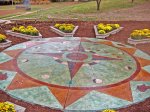 |
Crestwood |
Missouri |
USA |
Analemmatic Dial |
Dial 526 |
| This is a colorful analemmatic sundial 18 feet 6 inches overall diameter built of colored concrete. It is located on the grounds of a private elementary school in an area designated as a Sundial Garden. The sundial is surrounded by elevated flower planter boxes. The E-W markers are 10 feet apart and the date line is marked. The dial face shows the cardinal directions and phases of the moon. Viewing can be arranged by contacting Long Elementary School M-F 8:30 AM-3:15 PM. |
| |
| |
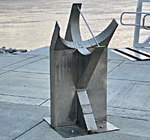 |
Hannibal |
Missouri |
USA |
Equatorial Dial |
Dial 1048 |
| A modernistic steel equatorial on a rectangular steel pillar. The gnomon rod shadow falls on an equatorial ring about 4-in (10cm) wide, showing time from V to VII, marked in hours and half hours. According to the Hannibal Courier-Post, "The sundial Scott Haycraft built 14 years ago is now back in its location at Glascock's Landing on the Hannibal riverfront...Haycraft built the 200-pound sundial with stainless steel. I wanted to make something that was functional art." |
| |
| |
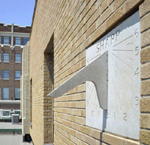 |
Joplin |
Missouri |
USA |
Vertical Dial |
Dial 979 |
| This is a simple but nicely engraved vertical sundial about 2-foot square made of concrete. The hour lines are delineated every half hour and marked on the hour in Arabic numbers. The gnomon is at least 1-inch thick, now epoxied into place. The hour lines converge correctly to the morning and afternoon toe of the gnomon, but no split noon hour line is seen. The dial is slightly recessed into the brick wall on the eastern edge correcting the Joplin street lay out of 1873 that used magnetic north that was 10 degrees east of north. |
| |
| |
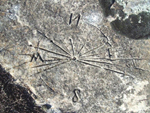 |
Monegaw Springs |
Missouri |
USA |
Sun Alignment |
Dial 888 |
| This compass is carved in rock showing cardinal points. For some reason the N mark is backward and a W mark is upside down. A surrounding circle of 10 inches in diameter defines most of the compass. A smaller circle encompasses the letter N and a partial circle carved from the center is approximately 4 inches in diameter. |
| |
| |
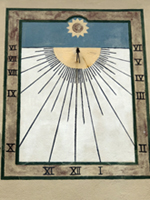 |
Perryville |
Missouri |
USA |
Vertical Dial |
Dial 916 |
| The sundial is attributed to Vincentian Brother Angelo Oliva, being painted sometime in the 14 year period between 1823, when he arrived in Perryville to lead the reconstruction of the original, wooden church into the present one made of stone, and 1837 when he died. The dial has been recently repainted. |
| |
| |
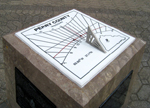 |
Perryville |
Missouri |
USA |
Horizontal Dial |
Dial 882 |
| The square 14.5-inch dial is made of while milk stone with graphics highlighted using lithochrome paint. The gnomon is made of stainless steel 303-alloy and has the letter P held between the base and style. The dial sits upon a square frustrum pedestal 3-feet tall, 24-inches square at the base, tapering to 17.5-inches at the top. The pedestal is supported on a 32-inch square base. |
| |
| |
 |
Rolla |
Missouri |
USA |
Sun Alignment |
Dial 301 |
| Stonehenge-like half-scale model. 5 trilithons. A south-facing trilithon carries a pierced brass plate which projects a spot of sunlight on a folded analemma pattern. Stone. |
| |
| |
 |
Saint Louis |
Missouri |
USA |
Sun Alignment |
Dial 1042 |
| The sundial, or more properly an alignment gap in the shape of a cross, is cut into the south wall of the Cascade Mausoleum. The cross shaped gap was cut into a 32,000-pound block of granite located at the top of the second flight of stairs, carefully angled at 27.9 degrees through this two-foot-thick block. Every year, on Dec 20th at 11:58 am, the sun shines through the cut and projects a cross 4x 8 feet in size on the granite floor located at the bottom of the stairs. The cross illuminates the floor for about 4 minutes, only aligning on Dec 20th at solar noon. |
| |
| |
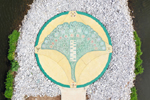 |
Springfield |
Missouri |
USA |
Analemmatic Dial |
Dial 1130 |
| Situated on a peninsula extending into Lake Drummund, this 25-foot (7.6m) double-ring analemmatic (human) sundial is easily seen on Google Earth. The mosaic dial shows both standard (6am-6pm) and daylight savings hours (7am-7pm). |
| |
| |
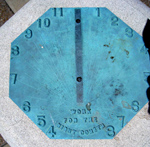 |
St. Louis |
Missouri |
USA |
Horizontal Dial |
Dial 889 |
| Sitting on a classic sundial pedestal is the Concordia sundial made of thin bronze plate in the shape of a hexagon about 8 inches between opposing sides. Hour lines radiate from where a thick gnomon would have stood, with Arabic numbers from 4am to 8pm counting the hours. The gnomon had gone missing in 2009 when the dial was vandalized. A new gnomon fitting the position of the old was designed by Don Snyder of St. Louis and made of bronze plate by William Turner of Turner & Associates, a metalworker also of St. Louis. |
| |
| |
 |
St. Louis |
Missouri |
USA |
Vertical Dial |
Dial 54 |
| This modernistic vertical south declining dial was designed by Mel Meyer and installed in 1989. The dial is an 8 by 10 foot stainless steel sundial with ribbed hour lines. No numerals are used. The gnomon is a solid triangle 3.5 inches wide by 85 inches high. |
| |
| |
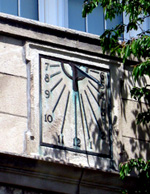 |
St. Louis |
Missouri |
USA |
Vertical Dial |
Dial 983 |
| The Mullanphy School is the last school of 48 designed by and constructed under the guidance of William B. Ittner (1864-1936), an architect and Commissioner of School Buildings for St. Louis, MO. Only hour lines are marked on this simple vertical sundial. The picture of the sundial was taken at 1:41 PM CDT on 7 May 2019. Using the relation T(solar) = T(civil) + EOT - Daylight - LonCorrection, with EOT=3.3m, Daylight=1h, and LonCorrection=1m, indicates that the dial should show 12:43:31. This suggests that Ittner’s sundial at the Mullanphy School displays this sundial time to a reasonable approximation, especially considering that its only time markings are hour lines. |
| |
| |
 |
St. Louis |
Missouri |
USA |
Horizontal Dial |
Dial 354 |
| A horizontal dial sculpture called "Child Sundial" depicts a daydreaming child figure playing with a sundial gnomon that is part of a working sundial. The gnomon is about 5 1/2 inches high and the hour lines are adjusted to show standard time in St. Louis. The sculpture and dial are at ground level surrounded by a bed of creeping thyme, perhaps a gentle Herb garden pun. Statue constructed of lead, 12 x 21 inches |
| |
| |
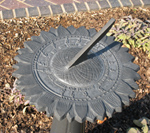 |
St. Louis |
Missouri |
USA |
Horizontal Dial |
Dial 941 |
| The dial has a horizontal plate about 10.5 inches in diameter made of bronze with a green-grey patina. The plate is sculpted as a sunflower. Hour lines are inscribed every 15 minutes and hours indicated in Arabic numbers. |
| |
| |
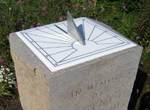 |
St. Louis |
Missouri |
USA |
Horizontal Dial |
Dial 918 |
| The dial plate is a 16 x 16 inch square piece of milk glass, with the hour lines and Arabic numerals made by sandblasting through a photo-etched stencil and then spraying black with lithichrome paint into the etchings. The triangular gnomon is made of 3/8 inch thick stainless steel. Saint Louis sculptor Abraham Mohler made the pedestal from EW Gold limestone quarried near Ste. Genevieve, MO. It is 18 x 18 inches square and 40 inches tall. |
| |
| |
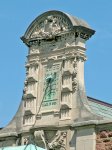 |
St. Louis |
Missouri |
USA |
Vertical Dial |
Dial 396 |
| A vertical decliner at the top of the Cupples I building. Given by the class of 1908. Can be seen from the courtyard of Robert S. Brookings building. In 1908 the campus newspaper, the Washington University Student Life, commented that "The new sun dial on Cupples I is now being put into position upon the tablet on the south side of the building?It will be interesting to note the discrepancy between sun time and standard time by comparing with the Varsity clock [a large time piece situated high on the west wall of Brookings Hall, with both clock and dial visible in the quadrangle]." Today the Baumont Pavilion, erected in 1965, blocks a close view of the ornate tablet and dial. Use binoculars from a distance. |
| |
| |
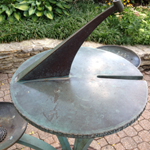 |
St. Louis |
Missouri |
USA |
Horizontal Dial |
Dial 891 |
| This horizontal sundial is part of a sculpture set, formed as a lily pad, and surrounded by three circular flowers with centers that are small water fountains (no longer working). The dial face is no longer flat and the graceful gnomon does not point true north. There is a short cylinder at the end of the gnomon with a hole, perhaps for casting a beam of light on a certain day. The hole is at a 34.4 deg angle, aiming toward the slot in the dial face. Now, the dial is located in dense shade preventing operation. |
| |
| |
 |
St. Louis |
Missouri |
USA |
Analemmatic Dial |
Dial 605 |
| A child-safe compliant surface analemmatic dial located in a roof garden. The dial face includes hour numerals, cardinal directions and moon phases. A nearby plaque give directions for use. |
| |
| |
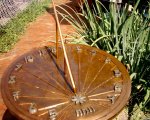 |
St. Louis |
Missouri |
USA |
Horizontal Dial |
Dial 525 |
| This horizontal sundial is a 30 inch diameter and 1.5 inch thick sealed, copper-coated steel plate with cast lead hour markers and weighs 250 pounds. Built in 2002, it was installed in September, 2004 in a private home rear yard. Dial is supported by 6x6 inch pressure treated wood post with 4x4 inch cross frame. Viewing can be arranged by contacting the owner. |
| |
| |
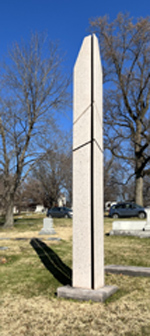 |
St. Louis |
Missouri |
USA |
Obelisk or Vertical Gnomon |
Dial 885 |
| The obelisk is constructed of North Carolina pink granite. At the base it is 18 x 16 inches and soars 18 feet into the sky. The obelisk displays a cross in its own shadow at solar noon on two days each year – the summer solstice on about June 21, and the winter solstice on about December 21. William Conrad Severson (1924-1999) was a St. Louis sculptor whose public artwork celebrated the sun. Examples are Solaris located at TECO Plaza in Tampa FL, Cosmos located in Saudi Arabia, and the sculptures of Les Danseuses and Primogenesis, both located in Clayton MO. Severson designed and had built the memorial obelisk for his family grave site, where he now rests as well. |
| |
| |
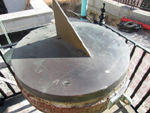 |
St. Louis |
Missouri |
USA |
Horizontal Dial |
Dial 883 |
| The circular bronze dial sits on an iron pipe, surrounded by a picket fence and protected from the elements by a brass hood. It is a nearly identical dial to the one at the St. Louis Arsenal (NASS dial #847), and was manufactured in the same year, 1859. It is likely that master armorer N. Engels, machinist A. Schaedel, and engraver W. Hawksley created this dial. The Old Courthouse Dial measures 17 inches in diameter, has a large unadorned triangular gnomon, and on the plate has hour lines from 6am to 6pm delineated every 15 minutes. There is a curious second set of hour lines at the top of the dial plate from 10am to 2pm. Hour numbers are in Roman numerals. There are no other engravings on the dial. |
| |
| |
 |
St. Louis |
Missouri |
USA |
Vertical Dial |
Dial 553 |
| A vertical dial of limestone and copper held in the hands of an angle statue. |
| |
| |
 |
St. Louis |
Missouri |
USA |
Horizontal Dial |
Dial 848 |
| The original sundial, made in 1841, was 14 inches in diameter and sat on a limestone pedestal 30 inches high. In early drawings from the late 1890's and later photos, the dial had a massive triangular gnomon. For years it served as the post chronometer. |
| |
| |
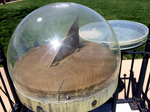 |
St. Louis |
Missouri |
USA |
Horizontal Dial |
Dial 847 |
| The circular bronze dial has a massive triangular gnomon and is kept under a protective plastic dome. In R. McGuire's book, St. Louis Arsenal - Armory Of The West is a picture of the sundial for which the caption reads "On December 12, 1859, master armorer N. Engels, machinist A. Schaedel, and engraver W. Hawksley dedicated a sundial, which they had created entirely from spare ordnance materials. It was a scientifically precise instrument, measuring 17 inches in diameter, and was used for many years as the definitive chronometer of the arsenal. Engraved upon it was a poem entitled 'The Bird of Liberty,' reflecting the patriotic fervor of the day." |
| |
| |
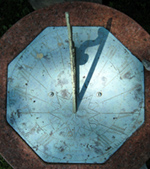 |
St. Louis |
Missouri |
USA |
Horizontal Dial |
Dial 836 |
| A horizontal sundial made on an octagonal brass plate, measuring 12 inches from side to side. The engraved hour lines are divided with marks for half, quarter and eighth parts of the hour. The hour numbers themselves are outward facing Roman numerals. The brass gnomon is bent slightly to the west by vandals. The pedestal is 37.5 inches tall with a 17 inch circular top cap of pink marble. Unfortunately the dial is located near a tree, so it is in shade for part of day. |
| |
| |
 |
St. Louis |
Missouri |
USA |
Equatorial Dial |
Dial 777 |
| A cast aluminum equatorial dial 15 inches in diameter with a rotating, two-part, three-dimensional analemmic gnomon; this is a classic Schmoyer dial completed by Bill Gottesman. One gnomon half is used from summer solstice to winter solstice; time is shown by a beam of light passing through the gnomon slit to fall on the hour ring. The other gnomon half is used from winter solstice to summer solstice. |
| |
| |
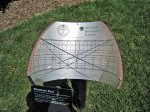 |
St. Louis |
Missouri |
USA |
Equatorial Dial |
Dial 776 |
| A 10 inch wide, cylindrical-segment equatorial dial 8 inches high, fabricated from a section of large PVC pipe. The dial face is aluminum sheet bonded to the PVC pipe and marked by photochemical engraving with hour lines showing analemmas to correct for EOT; hour lines are corrected for longitude and show both standard and daylight saving Arabic hour numerals. Winter and summer solstices and equinoxes are marked. Time and date are read by the shadow of the intersection of the two gnomon rods. Instructions are included on the dial face and plaque. |
| |
| |
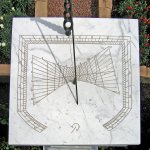 |
St. Louis |
Missouri |
USA |
Horizontal Dial |
Dial 626 |
| A unique horizontal dial 28 inches square and 1 inch thick of white Carrara marble with two cast bronze gnomons. Four time systems are shown on the dial. The shadow of the short vertical gnomon near the dial center indicates Ezanic hours based on a 24 equal-hour day with two 12-hour periods starting at sunset; Babylonian hours similarly based on two 12-hour periods starting at sunrise; and two Moslem prayer times, Zuhr and Asr. The polar gnomon shadow indicates hours based on two, 12 equal-hour periods starting at noon and midnight. The polar gnomon support consists of seven rings representing the celestial spheres of Sun, Moon, Mercury, Venus, Mars, Jupiter and Saturn. Dial furniture includes a Qibla showing the direction to Mecca, N 42.7° for this location. Dial markings are accentuated with inlaid gold leaf. This dial design is based on the Ottoman dial at Topkapi Palace, Istanbul, built about 1480, and on Ibn Al Shatir's dial in Damascus built 1371, the first sundial with a polar gnomon. Dial rests on three large carved marble blocks 42 inches high. The Botanical Gardens are public but require a moderate admission fee. |
| |
| |
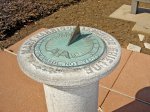 |
St. Louis |
Missouri |
USA |
Horizontal Dial |
Dial 622 |
| A 16.5 inch diameter bronze horizontal dial on a stone pedestal in front of the south entrance to the glass-walled Jewel Box building in Forest Park. The dial was erected by the Missouri Society Colonial Dames of America as a tribute to the memory of Mary Harrison Leighton Shields, who organized the Society in 1896 and served as its president until 1913. The dial face is inscribed, "WE LIVE IN DEEDS NOT YEARS." Dial furniture includes an hour glass and eagle wings. The perimeter around the dial is inscribed, "MARY HARRISON LEIGHTON SHIELDS." Dial sits atop a stone pedestal. |
| |
| |
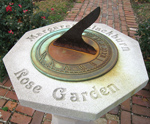 |
Webster Groves |
Missouri |
USA |
Horizontal Dial |
Dial 898 |
| This horizontal sundial is mounted on a hexagonal graceful concrete pedestal 43 inches high. The top of the pedestal is slightly sloping hexagonal 17 inches on a side. The circular bronze dial at the center is 11 inches in diameter. The hour lines meet a chapter ring with time marked in 15 minute intervals. Roman numerals mark the hours from 6am to 6pm. The 5 1/2 inch gnomon is of badly rusted steel, with iron stains covering the central part of the dial face. The sundial was vandalized at some time in the past and the original gnomon stolen. |
| |
| |
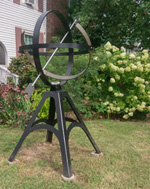 |
Webster Groves |
Missouri |
USA |
Armillary Sphere |
Dial 984 |
| The armillary sphere has three rings: (1) an equatorial time ring made of brass formed into an incomplete circular arc with a 36 inch inner diameter, a thickness of 1/2 inch, and width of 3 inches. Time markings in 15 minute intervals are inscribed on its inner surface with Arabic hour numbers; (2)a meridian ring made of steel formed into a circular arc 37 inches diameter, a thickness of 1/2 inch, and a width of 3 inches; and (3) a horizon ring made of steel into a circular arc 38 inches in diameter, with a thickness of 1/4 inch, and a width of 2 inches. The sundial is supported on a steel pedestal having an open square frustum construction. The gnomon is a steel rod having a pointed arrow tip aimed towards the North Celestial Pole. |
| |